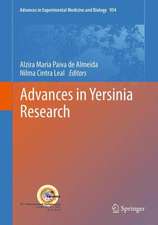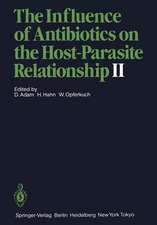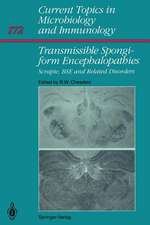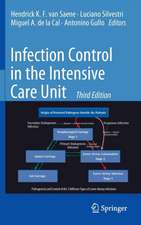Polysaccharides of Microbial Origin: Biomedical Applications: Polysaccharides of Microbial Origin
Editat de Joaquim Miguel Oliveira, Hajer Radhouani, Rui L. Reisen Limba Engleză Hardback – 2 mar 2022
This is an essential reference for students in biomedical, chemical, material, and microbiology engineering as well as researchers and professionals in the medical field.
Preț: 6425.34 lei
Preț vechi: 6763.51 lei
-5% Nou
Puncte Express: 9638
Preț estimativ în valută:
1229.88€ • 1336.37$ • 1033.76£
1229.88€ • 1336.37$ • 1033.76£
Carte disponibilă
Livrare economică 31 martie-14 aprilie
Preluare comenzi: 021 569.72.76
Specificații
ISBN-13: 9783030422141
ISBN-10: 3030422143
Pagini: 1292
Ilustrații: XXVIII, 1292 p. 256 illus., 166 illus. in color. In 2 volumes, not available separately.
Dimensiuni: 155 x 235 mm
Greutate: 2.77 kg
Ediția:1st ed. 2022
Editura: Springer International Publishing
Colecția Springer
Seria Polysaccharides of Microbial Origin
Locul publicării:Cham, Switzerland
ISBN-10: 3030422143
Pagini: 1292
Ilustrații: XXVIII, 1292 p. 256 illus., 166 illus. in color. In 2 volumes, not available separately.
Dimensiuni: 155 x 235 mm
Greutate: 2.77 kg
Ediția:1st ed. 2022
Editura: Springer International Publishing
Colecția Springer
Seria Polysaccharides of Microbial Origin
Locul publicării:Cham, Switzerland
Cuprins
Introduction.- Glucans.- Levan.- Gums.- Bacterial alginate.- Kefiran Xylinan (Acetan).- Succinolycan and Glucuronan.- Colanic acid.- Colominic acid.- Cyanobacterial polysaccharides.- Glycosaminoglycans.- Chitin.- Chitosan.- Pullulan.- Scleroglucan and Schizophyllan.- Sulphated seaweed polysaccharides.- Polysaccharides produced by marine microalgae.- Marine biotechnology and microbiology.- Microalgae metabolites.- Biosynthesis of levan.- Biosynthesis of fungal polysaccharides.- Production of natural gums Isolation and purification of chitosan.- Production of scleroglucan.- Production of EPS from lactic acid bacteria.- Isolation of microbial polysaccharides.- Biosynthesis of microbial polysaccharides.- Properties of fungal polysaccharides.- Bioactivities of bacterial polysaccharides.- Surface properties of polysaccharides.- Antioxidant and antibacterial activities of polysaccharides.- Microalgal antioxidants for human health.- Gel properties of microbial polysaccharides.- Polysaccharides in bacterial biofilm.- Polysaccharide functionalizations for hydrogels.- Polysaccharide modifications for drug delivery systems.- Genetically modified microorganisms.- Sulphation of microbial polysaccharides.- Dextran pharmaceutical applications.- New applications of glycosaminoglycan.- Polysaccharides in cancer therapy.
Notă biografică
Dr. Joaquim Miguel Oliveira (0000-0001-7052-8837),BSc, PhD, is a Portuguese Principal Investigator with Habilitation who has focused his work on the field of biomaterials for tissue engineering, nanomedicine, stem cells, and cell/drug delivery (http://www.3bs.uminho.pt/users/ migueloliveira). Since December 2018, he is VicePresident of I3Bs – Research Institute on Biomaterials, Biodegradables and Biomimetics of the University of Minho. He is also Director of Pre-clinical Research at the FIFA Medical Center, Estádio do Dragão, Porto, PT, since February 2013. Currently, he is a lecturer in Doctoral Program in Tissue Engineering, Regenerative Medicine and Stem Cells (TERM&SC) at UMinho, PT (since December 2013). He is also an invited lecturer at the Faculty of Medicine, U. Porto (since September 2013) and Department of Polymer Engineering, UM, PT (2009-present). Recently, he has been nominated for integrating the National Ethics Committee for Clinical Research (CEIC), Serviço Nacional de Saúde (SNS), Portugal, for the period of 2020–2023. He has been awarded several prizes including the prestigious Jean Leray Award 2015 from the European Society for Biomaterials for Young Scientists for Outstanding Contributions within the field of Biomaterials. In addition, he is member of the advisory board of the Journal of Materials Science: Materials in Medicine, International Journal of Tissue Engineering, Journal ISRN Biomaterials, the Journal of Experimental Orthopaedics, and one of the Editors-in-chief of In vitro Models (Springer), and is referee in more than 40 international journals. As result of his proficiency (as of November 2021), Dr. Oliveira has published more than 470 scientific contributions in scientific journals with referee (some in xiii high impact factor journals), 16 of those papers produced under invitation. Dr. Miguel Oliveira is inventor of 22 patents and published 10 books (+3 in preparation), 9 special issues/topical collections in scientific journals, 124 book chapters in books with international circulation, in international encyclopaedias, and science dissemination. He has great experience in intellectual property rights and patent exploitation. He has participated in more than 630 communications in national/ international conferences. Due to his expertise, he participated as invited/keynote speaker in more than 77 plenary sessions. He made great contributions in the osteochondral field, namely by proposing bilayered scaffolds, work that has been highly cited by its peers. Dr. Miguel Oliveira (as of November 2021) has an h-index of 54, i10 of 183, and received more than 10,700 citations (Google Scholar), or an h-index of 45 and ~7710 total citations (Scopus). He has an RG46.09 (ResearchGate).
Dr. Hajer Radhouani (0000-0003-1007-4073),Eng, MSc, PhD, is a postdoctoral researcher at the Portuguese Government Associate Laboratory ICVS/3B’s, University of Minho (https:// 3bs.uminho.pt/users/hradhouani). She graduated in Industrial Engineering in Agronomy (Agro-Industries and Biotechnologies) at Institut Supérieur Industriel Agronomique de Huy/Gembloux (Huy, Belgium) and obtained her European PhD in Technologic, Comparative and Molecular Genetics from the Universidade de Trás-os-Montes e Alto Douro (Vila Real, Portugal) in a collaboration with the Universidad de La Rioja (Logroño, Spain) and the Universidad de Vigo (Ourense, Spain). Since 2013, she has been working with biomaterials based on natural polysaccharides to treat different articular cartilage pathologies. Currently, she has been working on Kefiran polymer as a novel therapy for osteoarthritis treatment. She has published 54 publications listed in ISI Web of Knowledge, 3 international granted patents, and 8 book chapters, among others. She has a Scopus h-index of 22 and more than 1279 citations. She also presented more than 100 works (posters and oral presentations) in conferences and meetings. She has several scientific profiles such as E-1837-2011 (Researcher ID); 25724661600 (Scopus xiv About the Editors Author ID); orcid.org/0000-0003-1007-4073 (ORCID); FE1C-88E7-0A8A (Ciência ID).
Prof. Rui L. Reis (0000-0002-4295-6129), PhD, DSc, Hon. Causa MD, Hon Causa PhD, FBSE, FTERM, member of NAE, FAIMBE, FEAMBES, was born in 1967 in Porto, Portugal. He is a Full Professor of Tissue Engineering, Regenerative Medicine, Biomaterials and Stem Cells at the University of Minho (UMinho), Director of the 3B’s Research Group – member of the I3Bs – Institute for Biomaterials, Biodegradables and Biomimetics, and Director of the ICVS/3B’s Associate Laboratory, both of UMinho. He is also the CEO of the European Institute of Excellence on Tissue Engineering and Regenerative Medicine, the Global Past-President of the Tissue Engineering and Regenerative Medicine International Society (TERMIS), and the founding Editor-in-Chief of the Journal of Tissue Engineering and Regenerative Medicine. He is a recognized World expert inthe TERM and biomaterials fields who has edited several books and has more than 1375 published works listed on ISI Web of Knowledge with an h index of 95 (1260 works and h ¼ 100 in Scopus, and 2135 and h ¼ 119 in Google Scholar), being also an inventor of around 115 patents. Based on those, he co-founded several companies that raised important private investments. According to Google Scholar his work has been cited more than 63,000 times. He has been awarded many important international prizes, including among several others different innovation awards, the Jean Leray and George Winter Awards (ESB), the Clemson Award (SFB), the TERMIS-EU contributions to the literature Award, the TERMIS-EU Career Achievement Award, and in 2018 the UNESCO – International Life Sciences Award and the IET A. F. Harvey Engineering Research Prize. He is one of the most successful scientists working in Europe in the field of biomaterials, tissue engineering, and regenerative medicine and is the PI of projects with a budget totalizing more than 100 MEuros of which around 50 MEuros are UMinho funding. Researcher ID (A-8938-2008); Scopus Author ID 56861715700; ORCID 0000-0002-4295-6129.
Dr. Hajer Radhouani (0000-0003-1007-4073),Eng, MSc, PhD, is a postdoctoral researcher at the Portuguese Government Associate Laboratory ICVS/3B’s, University of Minho (https:// 3bs.uminho.pt/users/hradhouani). She graduated in Industrial Engineering in Agronomy (Agro-Industries and Biotechnologies) at Institut Supérieur Industriel Agronomique de Huy/Gembloux (Huy, Belgium) and obtained her European PhD in Technologic, Comparative and Molecular Genetics from the Universidade de Trás-os-Montes e Alto Douro (Vila Real, Portugal) in a collaboration with the Universidad de La Rioja (Logroño, Spain) and the Universidad de Vigo (Ourense, Spain). Since 2013, she has been working with biomaterials based on natural polysaccharides to treat different articular cartilage pathologies. Currently, she has been working on Kefiran polymer as a novel therapy for osteoarthritis treatment. She has published 54 publications listed in ISI Web of Knowledge, 3 international granted patents, and 8 book chapters, among others. She has a Scopus h-index of 22 and more than 1279 citations. She also presented more than 100 works (posters and oral presentations) in conferences and meetings. She has several scientific profiles such as E-1837-2011 (Researcher ID); 25724661600 (Scopus xiv About the Editors Author ID); orcid.org/0000-0003-1007-4073 (ORCID); FE1C-88E7-0A8A (Ciência ID).
Prof. Rui L. Reis (0000-0002-4295-6129), PhD, DSc, Hon. Causa MD, Hon Causa PhD, FBSE, FTERM, member of NAE, FAIMBE, FEAMBES, was born in 1967 in Porto, Portugal. He is a Full Professor of Tissue Engineering, Regenerative Medicine, Biomaterials and Stem Cells at the University of Minho (UMinho), Director of the 3B’s Research Group – member of the I3Bs – Institute for Biomaterials, Biodegradables and Biomimetics, and Director of the ICVS/3B’s Associate Laboratory, both of UMinho. He is also the CEO of the European Institute of Excellence on Tissue Engineering and Regenerative Medicine, the Global Past-President of the Tissue Engineering and Regenerative Medicine International Society (TERMIS), and the founding Editor-in-Chief of the Journal of Tissue Engineering and Regenerative Medicine. He is a recognized World expert inthe TERM and biomaterials fields who has edited several books and has more than 1375 published works listed on ISI Web of Knowledge with an h index of 95 (1260 works and h ¼ 100 in Scopus, and 2135 and h ¼ 119 in Google Scholar), being also an inventor of around 115 patents. Based on those, he co-founded several companies that raised important private investments. According to Google Scholar his work has been cited more than 63,000 times. He has been awarded many important international prizes, including among several others different innovation awards, the Jean Leray and George Winter Awards (ESB), the Clemson Award (SFB), the TERMIS-EU contributions to the literature Award, the TERMIS-EU Career Achievement Award, and in 2018 the UNESCO – International Life Sciences Award and the IET A. F. Harvey Engineering Research Prize. He is one of the most successful scientists working in Europe in the field of biomaterials, tissue engineering, and regenerative medicine and is the PI of projects with a budget totalizing more than 100 MEuros of which around 50 MEuros are UMinho funding. Researcher ID (A-8938-2008); Scopus Author ID 56861715700; ORCID 0000-0002-4295-6129.
Textul de pe ultima copertă
This book provides a comprehensive analysis of microbial polysaccharides, their current uses, and highlights biomedical opportunities. The topics comprise principally a) their extraction, isolation, purification and advanced production processes; b) characterization of their structural, physicochemical, and biological properties, among others, by several techniques; c) description of the advanced functionalization and modification methods for the polysaccharide based-material; and d) their applications and uses in medical and pharmaceutical fields. Each chapter is written by world-renowned academics and practitioners on their field.
This is an essential reference for students in biomedical, chemical, material, and microbiology engineering as well as researchers and professionals in the medical field.
This is an essential reference for students in biomedical, chemical, material, and microbiology engineering as well as researchers and professionals in the medical field.
Caracteristici
Presents the extraction, isolation, and production procedures of these microbial polysaccharides Describes the biological activities, structural and physicochemical properties of these polysaccharides Surveys advanced processing methodologies underlying tissue-engineered scaffolding and drug delivery systems
























